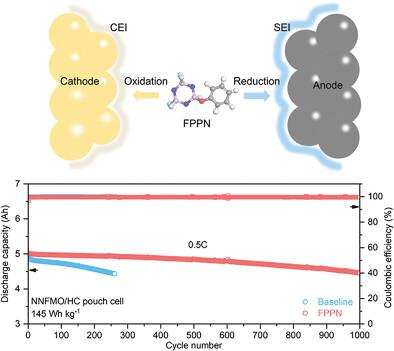当前位置:
X-MOL 学术
›
Adv. Mater.
›
论文详情
Our official English website, www.x-mol.net, welcomes your
feedback! (Note: you will need to create a separate account there.)
Pentafluoro(phenoxy)cyclotriphosphazene Stabilizes Electrode/Electrolyte Interfaces for Sodium-Ion Pouch Cells of 145 Wh Kg−1
Advanced Materials ( IF 27.4 ) Pub Date : 2024-01-22 , DOI: 10.1002/adma.202312287
Yaqi Liao 1, 2 , Lixia Yuan 2 , Yan Han 2 , Chaofan Liang 2 , Zezhuo Li 2 , Zhen Li 2 , Wei Luo 1 , Donghai Wang 1 , Yunhui Huang 2
Advanced Materials ( IF 27.4 ) Pub Date : 2024-01-22 , DOI: 10.1002/adma.202312287
Yaqi Liao 1, 2 , Lixia Yuan 2 , Yan Han 2 , Chaofan Liang 2 , Zezhuo Li 2 , Zhen Li 2 , Wei Luo 1 , Donghai Wang 1 , Yunhui Huang 2
Affiliation

|
Sodium-ion batteries are competitive candidates for large-scale energy storage batteries due to the abundant sodium resource. However, the electrode interface in the conventional electrolyte is unstable, deteriorating the cycle life of the cells. Introducing functional electrolyte additives can generate stable electrode interfaces. Here, pentafluoro(phenoxy)cyclotriphosphazene (FPPN) serves as a functional electrolyte additive to stabilize the interfaces of the layered oxide cathode and the hard carbon anode. The fluorine substituting groups and the π–π conjugated ─PN─ structure decrease the lowest unoccupied molecular orbital and increase the highest occupied molecular orbital of FPPN, respectively, realizing the preferential reduction and oxidization of FPPN on the anode and cathode simultaneously, which results in the formation of a uniform, ultrathin, and inorganic-rich solid electrolyte interlayer and cathode electrolyte interphase. The sodium-ion pouch cells of 5 Ah capacity rather than coin cells are assembled to evaluate the effect of FPPN. It can retain a high capacity of 4.46 Ah after 1000 cycles, corresponding to a low decay ratio of 0.01% per cycle. The pouch cell also achieves a high energy density of 145 Wh kg−1 and a wide operating temperature of −20–60 °C. This work can attract more attention to the rational electrolyte design for practical applications.
中文翻译:

五氟(苯氧基)环三磷腈稳定 145 Wh Kg−1 钠离子软包电池的电极/电解质界面
由于钠资源丰富,钠离子电池是大规模储能电池的有力候选者。然而,传统电解质中的电极界面不稳定,降低了电池的循环寿命。引入功能性电解质添加剂可以产生稳定的电极界面。在这里,五氟(苯氧基)环三磷腈(FPPN)用作功能性电解质添加剂,以稳定层状氧化物阴极和硬碳阳极的界面。氟取代基和π - π共轭结构─PN─结构分别降低了FPPN的最低未占分子轨道,增加了FPPN的最高占据分子轨道,实现了FPPN在阳极和阴极上同时优先还原和氧化,导致形成均匀、超薄且富含无机物的固体电解质中间层和阴极电解质界面。组装 5 Ah 容量的钠离子软包电池而不是纽扣电池来评估 FPPN 的效果。 1000次循环后仍能保持4.46Ah的高容量,相当于每循环0.01%的低衰减率。该软包电池还实现了 145 Wh kg −1的高能量密度和 −20–60 °C 的宽工作温度。这项工作可以引起人们对实际应用的合理电解质设计的更多关注。
更新日期:2024-01-22
中文翻译:

五氟(苯氧基)环三磷腈稳定 145 Wh Kg−1 钠离子软包电池的电极/电解质界面
由于钠资源丰富,钠离子电池是大规模储能电池的有力候选者。然而,传统电解质中的电极界面不稳定,降低了电池的循环寿命。引入功能性电解质添加剂可以产生稳定的电极界面。在这里,五氟(苯氧基)环三磷腈(FPPN)用作功能性电解质添加剂,以稳定层状氧化物阴极和硬碳阳极的界面。氟取代基和π - π共轭结构─PN─结构分别降低了FPPN的最低未占分子轨道,增加了FPPN的最高占据分子轨道,实现了FPPN在阳极和阴极上同时优先还原和氧化,导致形成均匀、超薄且富含无机物的固体电解质中间层和阴极电解质界面。组装 5 Ah 容量的钠离子软包电池而不是纽扣电池来评估 FPPN 的效果。 1000次循环后仍能保持4.46Ah的高容量,相当于每循环0.01%的低衰减率。该软包电池还实现了 145 Wh kg −1的高能量密度和 −20–60 °C 的宽工作温度。这项工作可以引起人们对实际应用的合理电解质设计的更多关注。

































 京公网安备 11010802027423号
京公网安备 11010802027423号